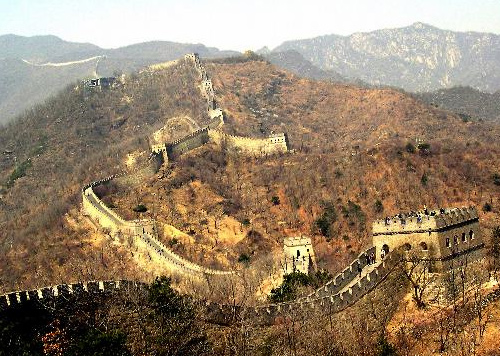
Source: The Great Wall Watchtowers, Central Intelligence Agency
Mountains are another important topographic feature. Urbanization occurred in flatter areas because they are easier to build on. So if you looked at a map and saw a town in a mountainous region it is likely to be fairly isolated and hard to get to (again, before cars and highways were common).
In the photo below, The Great Wall of China was built to protect China from intruders; mountains played an important role in the construction of the wall. In this photo, you can see multiple watchtowers along a section of the Great Wall.

Source: The Great Wall Watchtowers, Central Intelligence Agency
![]() Now, look at the two maps of China below. Compare the population map to the physical map. According to the population map of China, there are many cities along the coast, rivers, and borders with other countries (most likely to encourage trade or for protection). However, you do not see heavy urbanization within the more mountainous regions. The towns you do see are at the base of the mountains and so travel to them may be hard from the mountainous western side but not from the flatter Eastern side of China.
Now, look at the two maps of China below. Compare the population map to the physical map. According to the population map of China, there are many cities along the coast, rivers, and borders with other countries (most likely to encourage trade or for protection). However, you do not see heavy urbanization within the more mountainous regions. The towns you do see are at the base of the mountains and so travel to them may be hard from the mountainous western side but not from the flatter Eastern side of China.
In your notes respond to this question: The Tarim Basin, located in the Autonomous region of China, has a low elevation, but its population is basically uninhabited. Why do you think that virtually no one lives in this area of China?
Reflect on what you have learned so far about natural features and urbanization. What city do you live in? What natural features do you think affected urbanization in your hometown?
Use this link to find information about where you live.